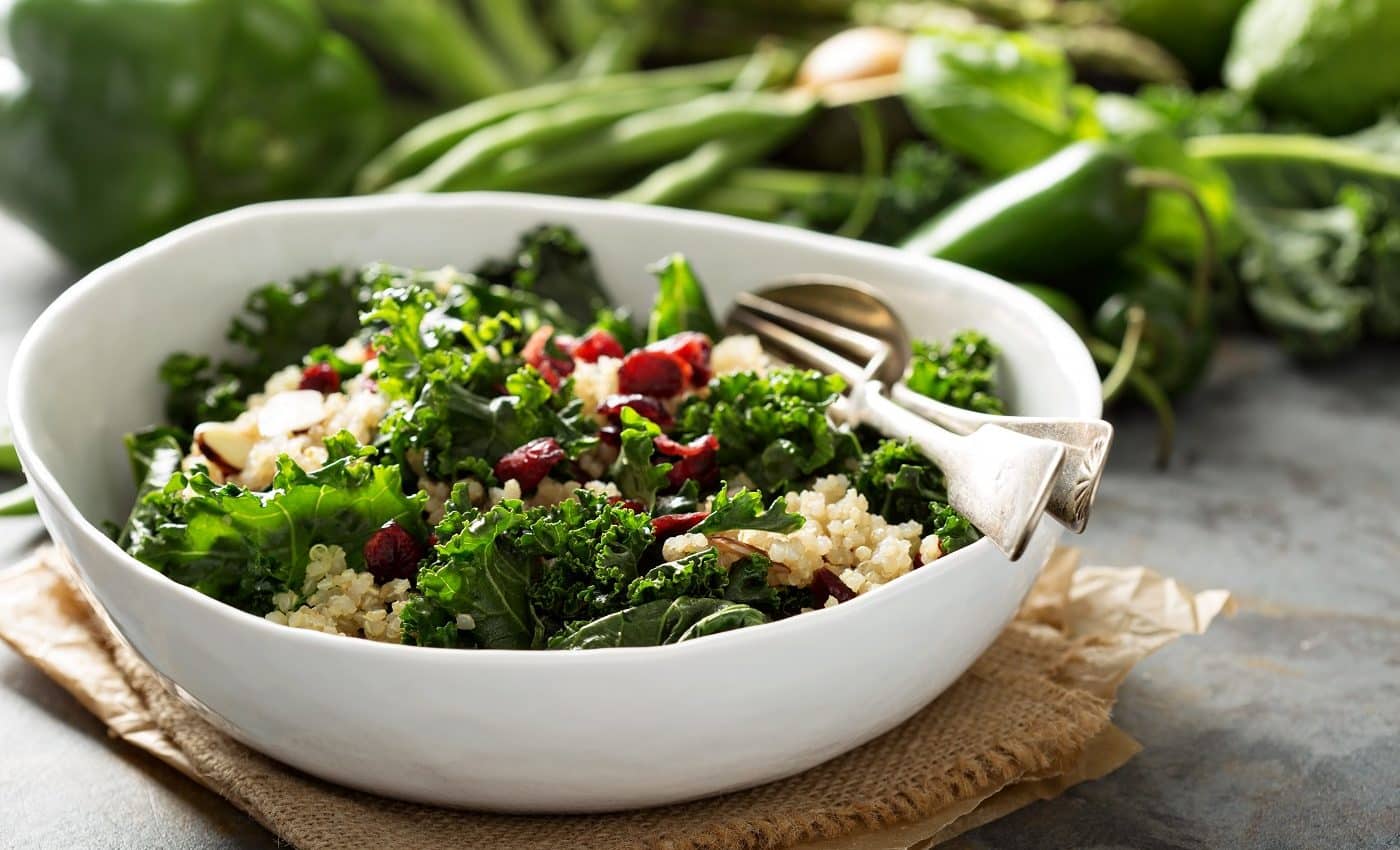There is still a lot of misinformation about vegan diets, including the myth that people need to consume dairy products in order to get enough calcium. In this article, ProVeg looks at the role of calcium in our bodies and shows that everyone’s calcium requirements can be met by a plant-based diet.
What is calcium?
The chemical element calcium is a key component of most plants and animals. A soft, silvery-white metal, calcium is never found in its pure form in nature since it easily forms compounds by reacting with oxygen and water. This naturally occurring element is the most abundant mineral in the human body and is vital to human health.
Functions of calcium
While it is well known that Calcium is an essential nutrient that keeps our bones and teeth healthy, it also plays an important role in our muscles, nerve transmission, blood clotting, hormone secretion, and other functions. 99% of the calcium in our body is found in our bones and teeth, while the remaining 1% is in our bloodstream and other tissues. Because some of the calcium in our bloodstream – which is absorbed from the bones – is lost through sweat, urine, and faeces, and because the body cannot produce additional calcium, we must consume sufficient calcium through food sources. Calcium plays a central role in the vital process of rejuvenating our bones, which continues throughout our life.1
Daily calcium requirements
While the recommendations for calcium intake vary considerably between regions, the following daily doses are recommended for people on a Western diet:2 3
- Adults: 700 mg
- Infants: 525 mg
- Children, aged 1 to 3: 350 mg
- Children, aged 4 to 6: 450 mg
- Children, aged 7 to 10: 550 mg
- Adolescent girls: 800 mg
- Adolescent boys: 1,000 mg
- Breastfeeding mothers: 1,250 mg
- Postmenopausal women: 1,200 mg
The effects of calcium deficiency
A lack of calcium in our diet is a risk factor for osteoporosis (weakness of the bones), which leads to a higher risk of fracture. Osteoporosis occurs because when we do not get enough calcium from our diet, it is reabsorbed from our bones, which act as a reservoir of calcium in our body.4 This means that getting enough calcium through the food we eat is extremely important. Low calcium levels can directly affect bone health and the variety of functions that calcium performs in the body.
Health effects of excessive calcium intake
While low calcium intake can lead to osteoporosis, an excessive intake of calcium (hypercalcaemia) can result in other health problems, including poor kidney function, tissue calcification, and constipation.5 However, unless one consumes high amounts of dairy products, calcium supplements, or excessive amounts of calcium-enriched food, developing hypercalcaemia is rare. The maximum recommended intake for adults between the ages of 19 and 50 is 2,500 mg of calcium per day.6
Foods rich in calcium
While, in the West, dairy products are often considered to be the main source of calcium, sufficient quantities of calcium are also found in many plant-based sources. In fact, there are numerous reasons for favouring calcium from plants: dairy products are not just a source of calcium, but are also one of the top sources of saturated fat,7 as well as a source of dietary cholesterol, sodium, and trans fats.
Chinese cabbage, kale, broccoli, collards, mustard greens, calcium-set tofu, navy beans, white beans, almonds, tahini, dried figs, and fortified products such as plant-based milk are all significant sources of calcium. (See Table 2 below for other examples.)
Absorption of calcium
It’s not just the amount of calcium we consume that is important but also its bioavailability – or how easily the body can absorb the calcium from a specific source. The bioavailability of calcium from plant sources depends on the extent to which oxalates or phytates are present – since both inhibit the absorption of this mineral. (The exception is soya, which is rich in both of these compounds but nonetheless has a high calcium absorption rate.)8 Blanching, soaking, and sprouting are highly effective ways to reduce the number of oxalates and phytates in vegetables without negatively affecting the nutritional composition.9
While dairy products are often considered to be the optimal source of dietary calcium, the calcium absorption rate from these foods (with the exception of cheese) is not as high as from dark green vegetables, as shown in the table above. Compared to dairy products, you can consume more calcium in the form of dark green vegetables. Compared to dairy products, you can consume more calcium in the form of dark green vegetables without overshooting your calorie goals. Because many manufacturers fortify soya milk with calcium, as well as other vitamins, such as B12, B2, D, and A, nutrition experts state that it can be used as a nutritionally adequate alternative to cow’s milk.10 11 This is confirmed by the US Department of Health and Human Services and the National Health and Medical Research Council in Australia.12 13 While the oxalate and phytate content of plant-based foods can reduce calcium absorption rates, plant foods are nonetheless a good source of this nutrient because they also provide other essential nutrients.
Calcium and vitamin D
In order for dietary calcium to be absorbed by the intestines, the presence of vitamin D is necessary. Sufficient levels of vitamin D can be achieved by sufficient bodily exposure to sunlight. In the summer months, a supplementation of vitamin D should not be necessary, so long as one spends a minimum of 20 minutes a day outside, in the sun. However, in the colder months, especially for people living in the northern hemisphere, vitamin D supplementation may be essential. Specific populations (such as office workers, children, and the elderly) may need vitamin-D supplementation even in summer. Before taking any supplement, it is strongly advised to have appropriate blood tests and consult with a medical professional.
Calcium supplements
While calcium supplements can be useful in cases of extremely low calcium intake or nutritional deficiency,14 there are associated gastrointestinal, renal, and cardiovascular risks.15 High intake of calcium from supplements can lead to vascular calcification and arterial stiffness, and might increase the risk of cardiovascular diseases.16 Overconsumption of nutrients through fortified foods is quite unlikely – food fortification is strictly regulated in most countries: the amounts of added nutrients are based on safety recommendations – which is not always the case with dietary supplements. Usually, only a fraction of daily requirements is covered by fortified products, e.g. most calcium-fortified plant milks contain 15% of the recommended daily amount of calcium per 100 millilitres, which amounts to 120 milligrams of calcium. The tolerable upper limit for calcium intake (the safe amount of calcium which can be ingested) is 2,500 milligrams.17 When consuming plant-based milk that is calcium-fortified, the container should be well-shaken as the calcium usually sinks to the bottom.
Table 1 – Amount of calcium in certain foods 18
Table 2 – Bioavailability of Calcium 19 20 21
Calcium supply for vegans and vegetarians
A well-balanced diet, free from animal products and rich in vegetables,fruits, legumes, whole grains, nuts, and seeds can provide sufficient calcium to the human body with none of the health risks associated with the consumption of dairy products., Additionally, the bioavailability of plant-based calcium is often higher than that of dairy products.22
However, it is important to ensure that the body gets a sufficient amount of vitamin D in order to optimise calcium absorption. Supplements should be considered as they offer a more controlled and more substantial quantity of vitamin D than fortified foods. In order to ensure healthy levels of calcium and vitamin D, and to find the right dosage for supplementation, blood tests and medical advice should be sought.
ProVeg tips for optimal plant-based calcium supply
- A vegan diet can provide a sufficient supply of calcium if enough plant-based calcium sources are consumed.
- Valuable sources of calcium include cruciferous vegetables, leafy greens, beans, sweet potatoes, almonds, sesame seeds and tahini, dried figs, algae, and mineral water, as well as fortified foods such as plant milks and tofu.
- Blanching or sprouting vegetables can decrease the presence of oxalates and phytates and thus increase the absorption of calcium.
- Plant-based sources of calcium can be a healthy alternative to calcium from dairy products.
- Spend enough time in the sun and consider taking vitamin D supplements during times when sunlight is scarce in order to boost calcium absorption.
References
- National Institute of Health (NIH) (2020): Calcium, Fact Sheet for Health Professionals. Available at https://ods.od.nih.gov/factsheets/Calcium-HealthProfessional/ [14.12.2020]
- WHO & FAO (2004): Vitamin and mineral requirements in human nutrition. Bangkok; 2004. Available from: http://apps.who.int/iris/bitstream/10665/42716/1/9241546123.pdf http://apps.who.int/iris/bitstream/handle/10665/42716/9241546123.pdf;jsessionid=369FEE7D5A5D0473CDCE851388E24276?sequence=1
- European Food Safety Authority (EFSA) (2015): Scientific Opinion on Dietary Reference Values for calcium. EFSA Journal 2015;13(5):4101
- National Institute of Health (NIH) (2020): Calcium, Fact Sheet for Health Professionals. Available at https://ods.od.nih.gov/factsheets/Calcium-HealthProfessional/ [14.12.2020]
- Institute of Medicine (US) Committee to Review Dietary Reference Intakes for Vitamin D and Calcium (2011): Dietary Reference Intakes for Calcium and Vitamin D. National Academies Press (US) Available at http://www.ncbi.nlm.nih.gov/pubmed/21796828 [22.03.2018]
- National Institute of Health (NIH) (2020): Calcium, Fact Sheet for Health Professionals. Available at https://ods.od.nih.gov/factsheets/Calcium-HealthProfessional/ [14.12.2020]
- Westhoek H., J.P. Lesschen, T. Rood et al. (2014): Food choices, health and environment: effects of cutting Europe’s meat and dairy intake. Glob Environ Chang. Elsevier Ltd; 2014;26(1):196–205
- Weaver, C. M., W. R. Proulx & R. Heaney (1999): Choices for achieving adequate dietary calcium with a vegetarian diet. American Journal of Clinical Nutrition. 70, p.543S–548S
- Paul V., S. Verma & A. Paul (2012) Effect of cooking and processing methods on oxalate content of green leafy vegetables and pulses. Asian J Food Agro-Industry. 2012;5(4):311–4. Available at www.ajofai.info [22.03.2018]
- Mäkinen O. E., Wanhalinna V., Zannini E. et al. (2016): Foods for Special Dietary Needs: Non-dairy Plant-based Milk Substitutes and Fermented Dairy-type Products. Crit Rev Food Sci Nutr. 56, p.339–349
- Parrish, C. R. (2018): Moo-ove Over, Cow’s Milk: The Rise of Plant-Based Dairy Alternatives. Practical Gastroenterology. p.20-27
- U.S. Department of Health and Human Services and U.S. Department of Agriculture (2015): 2015–2020 Dietary Guidelines for Americans. 8th Edition. December 2015. available at http://health.gov/dietaryguidelines/2015/ guidelines/. [14.12.2020]
- Australian Government, National Health and Medical Research Council, Department of Health and Ageing (2013): Eat for Health, Australian Dietary Guidelines. available at: https://www.eatforhealth.gov.au/sites/default/files/content/n55_australian_dietary_guidelines.pdf [14.12.2020]
- Gibson, P. S., M. J. Sadler & S. A. Lanham-New (2018): 3 – Authorised EU health claims for calcium and calcium with vitamin D (for low bone mineral density and risk of fractures). In: Foods, Nutrients and Food Ingredients with Authorised EU Health Claims. Woodhead Publishing p.35–47. Available at https://www.sciencedirect.com/science/article/pii/B9780081009222000036 [22.03.2018]
- Reid, I. R., S. M. Bristow & M. J. Bolland (2015): Calcium supplements: benefits and risks. J. Intern. Med. 278, p.354–368. Available at. http://www.ncbi.nlm.nih.gov/pubmed/26174589 [22.03.2018]
- National Institute of Health (NIH) (2020): Calcium, Fact Sheet for Health Professionals. Available at https://ods.od.nih.gov/factsheets/Calcium-HealthProfessional/ [14.12.2020]
- National Institute of Health (NIH) (2020): Calcium, Fact Sheet for Health Professionals. Available at https://ods.od.nih.gov/factsheets/Calcium-HealthProfessional/ [14.12.2020]
- U.S. Department of Agriculture (2020): FoodData Central. Available at https://fdc.nal.usda.gov/ [17.12.2020]
- Maciej S. Buchowski, 2015. “”Calcium in the Context of Dietary Sources and Metabolism””, Calcium: Chemistry, Analysis, Function and Effects, Victor R Preedy
- Zhao Y, Martin BR, Weaver CM. Calcium bioavailability of calcium carbonate fortified soymilk is equivalent to cow’s milk in young women. J Nutr. 2005 Oct;135(10):2379-82. doi: 10.1093/jn/135.10.2379. PMID: 16177199
- Weaver, C. M., Heaney, R. P., Connor, L., Martin, B. R., Smith, D. L., & Nielsen, S. (2002). Bioavailability of Calcium from Tofu as Compared with Milk in Premenopausal Women. Journal of Food Science, 67(8), 3144-3147. https://doi.org/10.1111/j.1365-2621.2002.tb08873.x
- Academy of Nutrition and Dietetics (2016): Position of the Academy of Nutrition and Dietetics: Vegetarian Diets. Available at https://www.eatrightpro.org/-/media/eatrightpro-files/practice/position-and-practice-papers/position-papers/vegetarian-diet.pdf [14.12.2020



